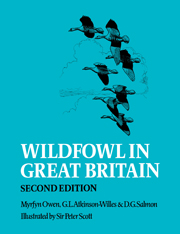Book contents
- Frontmatter
- Contents
- List of location maps
- Foreword by William Wilkinson
- Acknowledgements
- Conventions and abbreviations
- Part I Introduction
- Introduction to the survey
- Wildfowl Counts
- Wildfowl ringing
- Information from shot birds
- Part II The survey of wildfowl habitat and distribution
- Part III Species accounts
- Part IV The conservation of wildfowl and their habitats
- Conclusion
- References
- Indexes
Introduction to the survey
Published online by Cambridge University Press: 04 August 2010
- Frontmatter
- Contents
- List of location maps
- Foreword by William Wilkinson
- Acknowledgements
- Conventions and abbreviations
- Part I Introduction
- Introduction to the survey
- Wildfowl Counts
- Wildfowl ringing
- Information from shot birds
- Part II The survey of wildfowl habitat and distribution
- Part III Species accounts
- Part IV The conservation of wildfowl and their habitats
- Conclusion
- References
- Indexes
Summary
Two decades have passed since the publication, in 1963, of the First Edition of Wildfowl in Great Britain (edited by G.L. Atkinson-Willes, published by HMSO) – the first comprehensive survey into wildfowl habitats, stocks and prospects in Britain. Because of sparsity and irregularity of cover it proved impossible to include Ireland, either in the previous volume or in this work, but a separate study was carried out there recently (279).
The aim of the original survey was to provide a basis for conservation planning following the 1954 Protection of Birds Act and the formation by the then Nature Conservancy of the Wildfowl Conservation Committee to advise on wildfowl conservation and exploitation. Prior to this there had been much debate on the status of wildfowl and the effects of shooting, with conflicts arising largely from the lack of objectively gathered information on numbers and distribution. Wildfowl in Great Britain summarised the information collected during 14 years of Wildfowl Counts and provided a basis for future planning.
The volume more than adequately fulfilled its objectives and it continued until recently to provide basic data for cases of both national and local conservation. The last 20 years have, however, seen major changes not only in the habitat and conservation of wildfowl but also, partly as a result of this, in the status of most wildfowl species wintering in Britain. Following numerous requests from individuals and organisations for a new review the Nature Conservancy Council (NCC) and the Wildfowl Trust decided in 1979 that a complete reassessment should be undertaken.
- Type
- Chapter
- Information
- Wildfowl in Great Britain , pp. 2 - 3Publisher: Cambridge University PressPrint publication year: 1986

